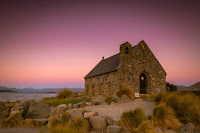Seventh Trumpet - Third Woe
When the seventh seal was opened, a half-hour of “silence” ensued before the seven angels began to sound their “trumpets.” During that interlude, the prayers of the “saints” were heard ascending to the throne of God. Now, when the “seventh trumpet” sounds, “loud voices” declare the triumph of the kingdom and the possession of the nations by the “Lamb” as promised in the second Psalm.














